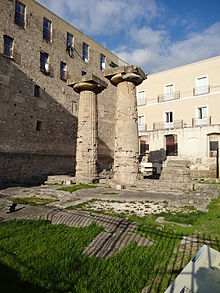Temple of Poseidon (Taranto)
The temple of Poseidon (also Doric temple according to its column arrangement) in Tarent from the first half of the 6th century BC. BC is the oldest temple of Magna Graecia and is the only place of Greek cult that can still be visited in the city's Borgo Antico. The ruins of the temple were in the Holy Trinity Church (Italian SS. Trinità), in the courtyard of the oratory of the Trinitarians (Brothers of the Most Holy Trinity), in the Mastronuzzi house and in the Celestini monastery .
In 1700 there were ten columns left , but they were removed and lost during renovations of the monastery in 1729. At the end of the 19th century, the temple was ascribed to Poseidon by archaeologist Luigi Viola , but is more likely to be related to female deities such as B. to bring Artemis , Persephone or Hera . Other finds were lost with the demolition of the monastery in 1926 and the church in 1973.
architecture
The two remaining columns and three drums of another were made of Carparo stone, a local type of limestone . They belonged to the northern part of the column wreath of the Doric Peripteros , the remains of which were found in the cloister and in the cellar of the monastery of San Michele.
Each column is 8.47 m high and has a diameter of 1.90 m (measured in the fluting ). The center distance of the two pillars obtained is 3.72 m. No further idea can be gained about the floor plan.
A small pit, which can be seen near the pillars, indicates a floor and a wooden elevation of a first place of worship made of bricks and perishable material, which dates back to the end of the 8th century BC. Was built by the first Spartan farmers. It is believed that the sanctuary was built at the end of the 3rd century BC. When the city was conquered by the Romans . In the 6th century it was reused, but not as a place of worship, but as a granary and for defense reasons when the population withdrew to the peninsula.
In the 10th century the remains of the temple became a Christian place of worship and from the 14th century a part was used for productive activities, such as B. for decanting clay and for small kilns.
See also
literature
- Robert Koldewey , Otto Puchstein : The Greek temples in Lower Italy and Sicily . Asher, Berlin 1899, p. 62 ( uni-heidelberg.de [accessed on August 13, 2012]).
Web links
Coordinates: 40 ° 28 '25.6 " N , 17 ° 13' 58.8" E
